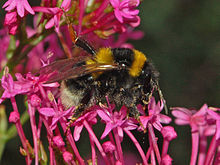Large garden bumblebee
| Bombus ruderatus | |
|---|---|
 |
|
| B. ruderatus on Centranthus ruber, Genova, Italy | |
| Scientific classification | |
| Kingdom: | Animalia |
| Phylum: | Arthropoda |
| Class: | Insecta |
| Order: | Hymenoptera |
| Family: | Apidae |
| Genus: | Bombus |
| Species: | B. ruderatus |
| Binomial name | |
|
Bombus ruderatus (Fabricius, 1775) |
|
Bombus ruderatus, the large garden bumblebee or ruderal bumblebee, is a species of long-tongued bumblebee found in Europe and in some parts of northern Africa. This species is the largest bumblebee in Britain and it uses its long face and tongue to pollinate hard-to-reach tubed flowers. Bumblebees are key pollinators in many agricultural ecosystems, which has led to B. ruderatus and other bumblebees being commercially bred and introduced into non-native countries, specifically New Zealand and Chile. Since its introduction in Chile, B. ruderatus has spread into Argentina as well. Population numbers have been declining and it has been placed on the Bioadversity Action Plan to help counteract these declines.
Bombus ruderatus is part of the order Hymenoptera and the family Apidae. B. ruderatus is in the genus Bombus and is one of 239 species of bumblebees, with 23 of those existing in Britain alone.B. ruderatus is part of the subgenus Megabombus, along with Bombus hortorum.B. ruderatus is most closely related to B. hortorum.
The body lengths of B. ruderatus reach about 22 mm (0.87 in) in queens, 16 mm (0.63 in) in workers and 15 mm (0.59 in) in males. It has a long face and tongue, which is well adapted for feeding on long-tubed flowers. The basic color of the body is black with two yellow bands on its mesonoma—one on its scutellum and one on its pronotum—and a single thin yellow band on the abdomen. A black band is located on the interwing and separates the two yellow bands on the thorax. Similarly, queens are the most difficult to find as the bee is scarce in many areas and queens are less abundant within a colony itself.
There are many similarities between B. ruderatus and B. hortorum, making it difficult to distinguish between the two species. Due to numerous physical similarities, many scientists have suggested reassessing their current status as two distinct species. Both bees are similar sizes, are black with two yellow bands, and the drones have similar genitalia. Although they may be hard to assess at first glance, there are minor physical differences. For example, the width of two yellow bands on the scutellum and pronotum are relatively equal in B. ruderatus, while in B. hortorum, the band on the scutellum tends to be narrower than the band on the pronotum. Physical variations may exist within a species as well, making it important to use other sources to distinguish between the two species. Studies of mitochondrial DNA has shown a 6.2% divergence for and a 9.2% divergence for . These percentages are higher than the divergences between other distinct species, affirming that these bees are in fact two distinct species.
...
Wikipedia
